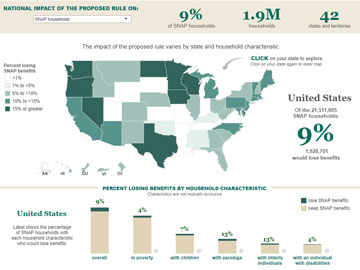In February 2020, almost 30 million children in 94,000 schools across the country ate lunches provided through the federal National School Lunch Program; about 15 million children ate federally funded breakfasts at school. Most children served by these programs are in families with low incomes, and these meals fill both nutritional and economic needs. During the COVID-19 pandemic, even as school cafeterias shuttered to keep students and teachers safe from the virus, these needs have only grown. Many families’ financial situations have worsened, and the proportion of households with children experiencing food insecurity has increased.
When the pandemic hit the United States in spring 2020, Congress recognized the need for emergency support for child nutrition programs and, beginning with the Families First Coronavirus Response Act, provided additional funding and program flexibilities. At the same time, the U.S. Department of Agriculture’s Food and Nutrition Service (FNS) and the states took steps to help local operators of child nutrition programs serve meals to children during school closures. Since then, Congress and FNS have supported state and local efforts to provide access to meals during the pandemic, and recently, the Biden administration expanded nutrition assistance benefits to children in families with low incomes.
As school buildings closed because of the pandemic, federal child nutrition programs beyond the traditional school meals programs became central players in local efforts to feed children. The Summer Food Service Program and the National School Lunch Program’s Seamless Summer Option are named for their goal of providing meals to children during the summer, yet they also provide meals to children during unanticipated school closures, such as those related to weather events or natural disasters.
Before the pandemic, local program operators faced challenges feeding children through these programs, resulting in substantially fewer children receiving meals during the summer than during the school year. The summer meals programs are structured somewhat differently from the school meals programs, as summer meals are served in a variety of settings by a range of organizations. At the same time, both school and summer meals programs require meals to be served to and consumed by children at specified locations and defined times. Although this requirement makes sense for school meals programs, which are served to children in school buildings during the school day, it creates challenges for summer meals programs that operate during periods when children do not routinely congregate at defined locations.
When schools closed because of the threat of COVID-19, FNS quickly acted to facilitate access to meals by removing some of the long-standing challenges to feeding children through the summer meals programs. For example, FNS waived federal requirements for congregate meals, children’s presence at meal pickup, the amount of time required between each meal service, and the proportion of children from families with low incomes that had to live in an area in order for all children who participated to receive free meals (see Figure 1). FNS initially approved these waivers for a few months, but as the pandemic continued, the agency extended them through the end of the 2020–2021 school year.
Figure 1. FNS COVID-19 child nutrition waivers that addressed long-standing challenges to feeding children through summer meals programs
| Program challenge | COVID-19 waiver | Program change |
|---|---|---|
| Children must consume meals in a congregate, or group, setting. | Non-Congregate Feeding Waiver | Children do not need to consume meals in a group setting. |
| Children must pick up meals at meal sites. | Parent/Guardian Meal Pick-Up Waiver | Parents and guardians may pick up meals for their children. |
| Meals, such as breakfast and lunch, must be served at different times. | Meal Times Waiver | Meals, such as breakfast and lunch, may be served at the same time. |
| Free meals are provided to children at meal sites located in areas where at least half of children are from families with low incomes.a | Area Eligibility Waiver | Free meals may be provided to children at meal sites located in areas that do not meet the specified income requirement. |
a These sites are located in areas where at least half of the resident children are eligible for free and reduced-price school meals because their families have incomes at or below 185 percent of the federal poverty level. Any child may obtain a meal for free from these sites.
In approving these waivers during the pandemic, FNS created a nationwide experiment through which program operators were able to try a variety of new approaches to serve meals to children during school closures. Recently released data from FNS highlight the importance of these new approaches, as they confirm that the summer meals programs served an unprecedented number of meals during the early months of the pandemic. Yet these data also show the ongoing difficulty of feeding children when schools are closed, as the total number of meals served through the child nutrition programs during the early months of the pandemic was substantially lower than the number of meals served in schools in the months before COVID-19.
This spring, my colleagues and I at Mathematica will collect information for FNS on how states and local program operators used the child nutrition program waivers during the pandemic and the impacts the waivers had on serving meals to children (contingent upon Office of Management and Budget approval). We are excited to collect this information, as it will provide important insights into how the program flexibilities helped local program operators feed children during the pandemic. Moving forward, this information also could be used to support long-term, evidence-based policy changes that improve our country’s efforts to provide year-round nutritional support to children in need. Hunger and food insecurity do not disappear just because school is out, and though the pandemic waivers will eventually expire, they provide an opportunity to inform long-term solutions.



